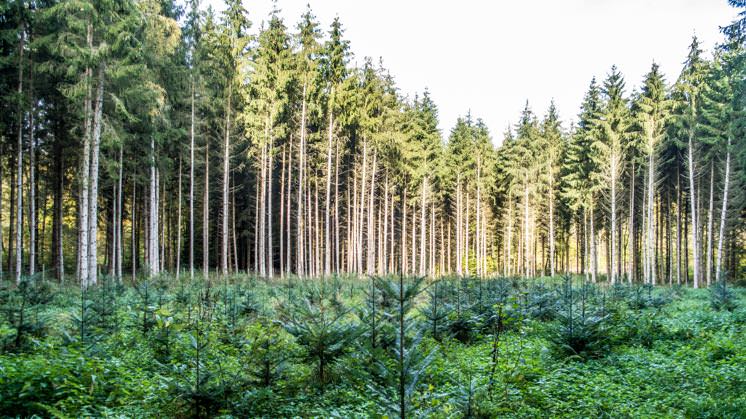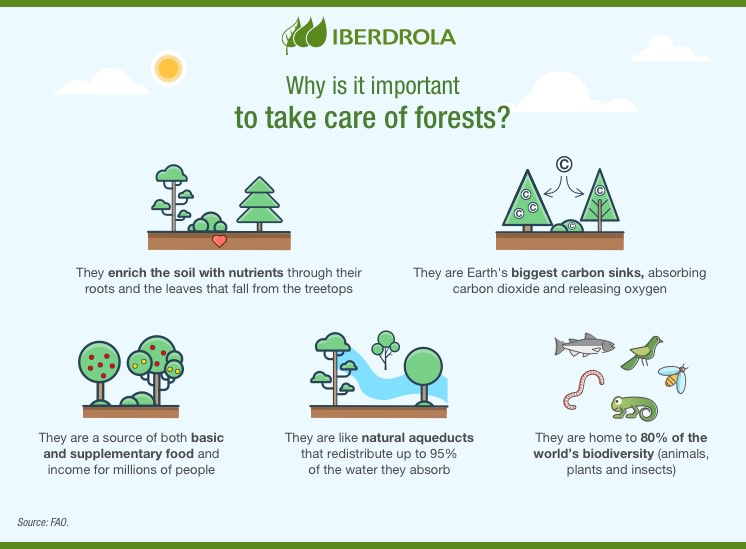Reforestation
Reforestation as an option for reversing deforestation
Desertification, or loss of fertile, productive soil, is a problem which is exacerbating climate change, because the diminishing number of trees on the planet is worsening the greenhouse effect. One solution to this is reforestation. Despite its drawbacks, it is still an option for regreening thousands of hectares.

Life on Earth could not survive without forests. The forests and oceans are the lungs of the planet and they have a crucial role in the fight against climate change because they absorb 20 billion tonnes of CO2 per year. CP2 is the primary gas responsible for the greenhouse effect and the main culprit in global warming. The importance and value of Earth's ecosystems is so clear that caring for and respecting them is part of the Sustainable Development Goals (SDG). Specifically, ODS 15: Life in terrestrial ecosystems protect, restore and promote their sustainable use.
Almost a third of the planet is covered by forests. That is equivalent to 40.6 billion hectares. These enormous forested areas are essential to our survival: the water we drink, the food we eat and the air we breathe. However, we are destroying our very source of life: humankind is cutting down 13 million hectares of forest each year.
Our overexploitation of natural resources, by cutting down trees and building ever-larger cities, is the main human cause of desertification, but there are others that are not related to it. These activities are causing irregular rainfall and seasonal drought, soil erosion and impoverishment, and forest fires caused by climate change. In light of this situation, reforestation has become one of the most effective strategies for turning this trend around.
What is reforestation. Goals and benefits
Reforestation consists of replanting deforested areas to restore forests destroyed in the recent past. The destruction of large forests, which are essential to absorb CO2, produce oxygen and palliate climate change, make it necessary to plant huge numbers of new trees with the ultimate aim of saving ecosystems from destruction and protecting the planet from damage.

SEE INFOGRAPHIC: Why is it important to take care of forests? [PDF] External link, opens in new window.
Reforestation, therefore, is a way of achieving an array of objectives, all of which seek to restore the stability offered by forests:
 Restore lost biodiversity
Restore lost biodiversity
Our forests are home to more than 80 % of the species that live on Earth. According to The State of the World's Forests 2020 (FAO) they house more than 60,000 species of tree, 80 % of amphibians, 75 % of birds and 68% of mammals. Their destruction and disappearance is driving hundreds of species to extinction despite the efforts of conservationists. The European Union's Biodiversity Strategy for 2030 foresees planting at least 30 billion trees in Europe to help to protect biodiversity.
 Reduce the amount of carbon dioxide in the air
Reduce the amount of carbon dioxide in the air
Human beings' activities cause annual emissions of around 40 Gt CO2. Half of these gases end up in the atmosphere where they contribute to global warming, and the other half is absorbed by forests and oceans. Reforestation is crucial for our very survival: our forests are carbon sinks and essential for stopping climate change. Without them, the average temperature of the planet will continue to increase, and so will sea levels. Glaciers and polar ice caps will keep melting among other climate effects.
 Reverse soil erosion and restore water basins
Reverse soil erosion and restore water basins
The trees in the forest hold back the wind and rainfall, protecting the soil from erosion. Eroded, infertile soil is no good for farming and is at risk of landslides and flash flooding. Reforestation is a remedy to this situation, which is also being made worse by indiscriminate tree felling, preserving soil fertility with deep roots. Water basins also come back to life when they recover their nutrients.
 Protecting human health
Protecting human health
Deforestation and its effects on the environment not only deprive people of essential nutrients, but are also the main sources of transmission of emerging infectious diseases, including COVID-19. A total of 75 % of these diseases (including bird flu and Ebola) are transmitted from wildlife to people. Forest degradation without optimal reforestation increase human exposure to zoonotic diseases.
Types of reforestation
Depending on the area replanted, there are two types of reforestation:
- Urban reforestation. This is tree planting in developed areas. The purpose depends on the city's needs: modify the climate — green zones are good for beating the heat —, improve air quality — heavy traffic in cities increases CO2 levels — provide more shady areas or enhance the appearance of the environment.
- Rural reforestation. Huge numbers of trees are planted in areas that have suffered deforestation, places which were once forests, jungles or covered with semi-arid vegetation. Forests can also be planted in areas where they have never existed, although the correct term in this case would be forestation. There are different subtypes within reforestation depending on the intention. Conservation, protection and restoration, agro-forestry and productive.
How to carry out reforestation
To reforest a piece of land spoilt by indiscriminate felling, fires or deforested by climate change, you need a plan. Reforestation needs to be sustainable, in other words, it is not just a question of planting trees here and there, willy-nilly. Let's take a look at some of aspects to consider:
 Site study
Site study
First of all, the land must be analysed and the conditions of the area must be checked: from the soil — depth, texture, fertility — to the climate — dry or wet season (there must be moisture) — and the type of local fauna and flora that live in the ecosystem.
 Choose which species to plant
Choose which species to plant
It is recommended to plant local species, but it is also acceptable to included fast-growing species that are compatible with the soil and the climate. It is important to have good quality forest germplasm, and ideally the nursery of origin should be no more than 100 kilometres away. The manner and time at which the trees are transported is also important to avoid the heat of the sun and strong wind.
 Choose a planting method
Choose a planting method
First prepare the soil, select the right tools and opt for the least invasive technique. Tree height and coverage of each new plant must be considered so that they do not interfere with each other. The plantation does not end with the forest germplasm, but must also include a follow-up plan.
 Establish a protection plan
Establish a protection plan
The follow-up plan must specify how to protect the reforested area from threats of disease, infestation, fire and illegal logging, among others. Maintenance and assessment are essential to secure the reforestation.
Problems with reforestation
According to the Global Forest Resources Assessment 2020 (FAO), more than 20 billion hectares of forest in the world have management plans. Preparing guidelines for the correct operation of forests is a crucial starting point when it comes to restoring a forest or starting to recreate one, because, like in any process, problems may arise at any time:
- If the reforestation is impulsive - in other words, if it does not have a good implementation plan — it can be counterproductive and detrimental to the diversity of species or to agricultural crops.
- Large forest crops can have the opposite effect to that desired, drying out and impoverishing the soil due to excessive salinity.
- The wrong choice of tree and method by which they are planted and positioned can all have negative effects. What is more, introducing invasive species may cause the extinction of others.
- Badly planned reforestation may lead to a monoculture that not only affects the diversity of the indigenous flora but also the habitats of the different creatures who live in the forest.




